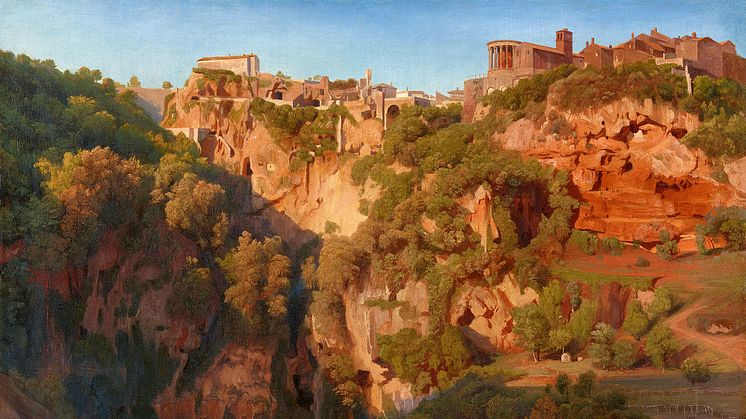
Press release -
New Acquisitions - Three Travelling German Artists
Nationalmuseum has acquired three landscapes by travelling German artists. Ernst Fries’ The Waterfalls at Tivoli with the Ponte Lupo, Temple of Vesta, and Temple of Sibyl, Carl Morgenstern's View towards Sorrento, and Georg Eduard Otto Saal’s Study of Vermafossen Waterfall. Nationalmuseum’s collections previously contained no works of this kind by German artists.
The three new acquisitions will make it possible to more clearly illustrate the international tendencies of the artistic activity of the 19th century. Artists of different nationalities travelled to the same destinations and painted the same scene. The museum's collections include paintings of the same sites by French, Danish and Swedish artists, among others.
One obvious commonality in the three paintings is the distance to the subject – in all three cases, the artist chose to situate the famous site in the distance. The views invite the gaze to explore pathways, spaces, and buildings, and demonstrate how far-off landscapes and a long distance perspective became central to German art of the Romantic era. For example, the eponymous protagonist in Goethe’s The Sorrows of Young Werther prefers to consider landscapes at a distance, because this allows him to experience them through his imagination. From one side of a valley, he can use his gaze to climb up and down the steep precipices on the other side. Yet once he physically arrives there, the magic vanishes and his eyes seek out the next view in what has now become the distance.
The three newly acquired paintings seem to be imbued with the same relationship with nature and the landscape. One can think of their creation as an equivalent to the kind of distanced experience that Werther preferred to physical exploration of a place.
When Ernst Fries died at the young age of 31, he had not really had time to establish himself as an artist in Karlsruhe, where he settled after his four-year stay in Italy. Therefore, he did not leave behind a wealth of artistic production. Thus, Nationalmuseum’s newly acquired The Waterfalls at Tivoli is a rarity. Judging by the fresh painting style and sharp treatment of the light, this work was at least partially executed on location and en plein air, when the artist visited Tivoli in October 1826. Fries is said to have been particularly fascinated by cascades and grottoes, and it is tempting to see the image as an imaginatively rendered experience of one of the most famous and dramatic landscapes of its kind.
In 1834, Carl Morgenstern travelled to Italy, where he remained for three years. He painted extensively along the Amalfi coast and on Capri – two of the most important destinations for artists. His study from a point just above Sorrento demonstrates one of his specialties, a subtle atmospheric perspective in a pale blue-violet tone. It is particularly interesting that he sat in an opening in the rock, presumably to exploit the shadow that falls in the foreground and a bit into the picture, and so that he could paint the sun-drenched view without being bothered by the light.
German artists did not only travel to the south. Later in the century, Scandinavia became another popular destination – especially Norway, which could offer the most striking scenery, with waterfalls, mountains and fjords. Georg Eduard Otto Saal’s Study of Vermafossen Waterfall is painted entirely on site, in front of the subject. With its lively trees and roaring waterfalls, the painting is a very fine example of how artists developed a technique for achieving a high degree of illusion using the simplest and fastest possible brush strokes.
Nationalmuseum receives no state funds with which to acquire handicrafts and artwork; its collections are enriched through donations and funds from private foundations and trusts. This acquisition has been made possible by a generous contribution from the Wiros Fund.
Inventory Numbers
Georg Eduard Otto Saal, Study of Vermafossen Waterfall, NM 7433
Carl Morgenstern, View towards Sorrento, NM 7447
Ernst Fries, The Waterfalls at Tivoli with the Ponte Lupo, Temple of Vesta, and Temple of Sibyl, NM 7472
Further Information
Carl-Johan Olsson, Curator, carl-johan.olsson@nationalmuseum.se, +46 70 967 67 93
Mattias Robertson, Press Officer, press@nationalmuseum.se, +46 767 23 46 32
Related links
Categories
Nationalmuseum is Sweden’s museum of art and design. The collections comprise older paintings, sculpture, drawings and graphic art, and applied art and design up to the present day. The museum building is currently under renovation and scheduled to open again October 13, 2018. In the meantime, the museum will continue its activities through collaborations both in Sweden and abroad. Nationalmuseum has partnerships with Svenska Dagbladet and the Grand Hôtel Stockholm.

